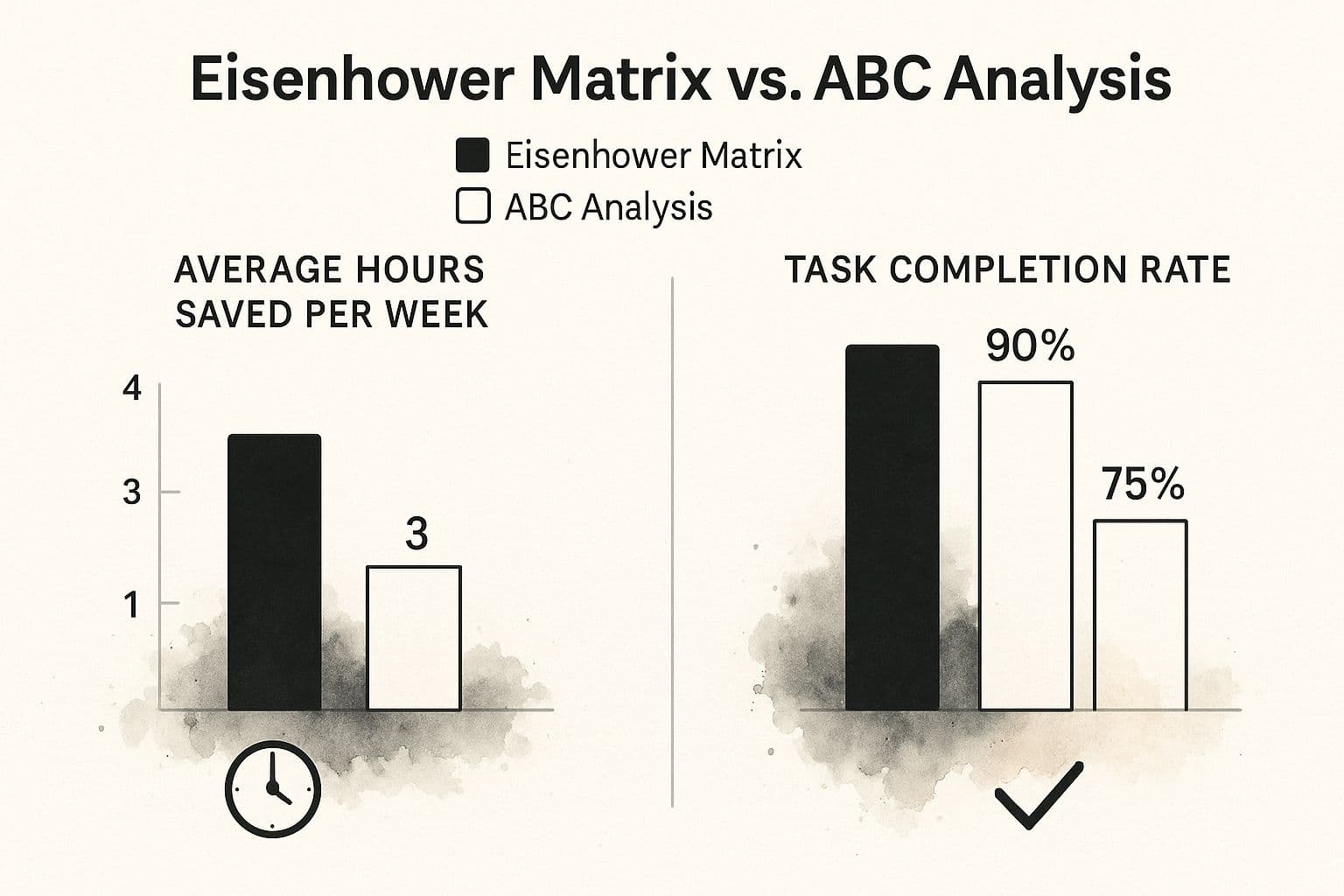Discover how to improve workflow efficiency with our guide. Learn proven strategies for automating tasks, streamlining communication, and boosting productivity.
September 28, 2025 (2mo ago)
How to Improve Workflow Efficiency for Better Results
Discover how to improve workflow efficiency with our guide. Learn proven strategies for automating tasks, streamlining communication, and boosting productivity.
← Back to blog
To boost your workflow efficiency, you first need to get a clear, honest look at how things are running right now. You can't fix what you can't see, so the first real step is mapping out your current processes to find those hidden snags. This isn't just about drawing diagrams; it's about creating a solid foundation for smart, effective improvements.
Mapping Your Current Workflow to Find Hidden Flaws

Before you can make anything faster or smoother, you've got to understand how work actually gets done. It’s easy to think we know our own processes, but the day-to-day reality is often a patchwork of unofficial workarounds that quietly eat up time and energy.
The goal here isn't to create some overly formal, complex chart. It’s about getting a practical picture of the journey a task takes from start to finish. Think of it as creating a diagnostic map where you can finally see exactly where the pain points are.
Start with the People on the Ground
Your first move? Talk to the team members who are hands-on with the process every single day. They're your best source of truth. They know precisely where the logjams happen, which steps feel pointless, and where communication constantly goes sideways.
Ask them to walk you through a typical task, step-by-step. Just listen and take notes—don't jump in to solve anything yet. I guarantee you’ll uncover "shadow workflows"—those unofficial steps people take to get the job done that aren't written down anywhere.
The most valuable insights always come from the people on the front lines. They feel the friction firsthand and often have surprisingly simple ideas for how to fix it.
Hunting for the Three Big Time-Wasters
As you map everything out, you’re really looking for three specific culprits that are notorious for killing efficiency. Finding these gives you a clear starting point for immediate gains.
- Bottlenecks:** Where does work always seem to pile up? A bottleneck is any point where tasks are coming in faster than they can be handled, creating a frustrating traffic jam. A classic example is a single manager who has to approve every minor request, holding up multiple teams.
- Redundancies: Are people doing the same thing twice? This crops up a lot when systems don't talk to each other. For instance, the sales team enters customer info into the CRM, and then the finance team has to manually type that same data into the billing software. It's a total waste of time.
- Communication Gaps: Where does information get lost in translation? It could be a vague handoff between marketing and sales, or a project that stalls because someone missed a critical update in a long email chain. These gaps always lead to rework and blown deadlines.
The table below can help you quickly identify these common time-wasters in your own processes.
Common Workflow Inefficiencies and How to Spot Them
| Inefficiency Type | Real-World Example | First Action to Take |
|---|---|---|
| Bottlenecks | All design mockups require approval from a single director who is always in meetings. | Explore delegating smaller approvals or using an asynchronous review tool like Figma. |
| Redundancies | A project manager manually copies updates from Asana into a weekly PowerPoint slide deck for leadership. | Set up an automated report or dashboard that pulls data directly from the source. |
| Communication Gaps | The development team isn't notified when a high-priority bug is reported by customer support, causing delays. | Create an automated Slack notification in a dedicated channel whenever a "high-priority" ticket is created. |
Once you've pinpointed these weak spots, you finally have a clear plan of attack. For inspiration on how other companies have tackled similar issues, these process improvement examples show these principles in action. This initial audit gives you the clarity you need to stop guessing and start making changes that actually matter.
Using Automation to Eliminate Manual Drudgery
Once you have a clear map of your workflow and you've pinpointed the real bottlenecks, it's time to tackle the manual drudgery. Think about all those little repetitive tasks that slowly chip away at your day—copy-pasting data from one app to another, manually sending the same follow-up email, or pulling numbers for a weekly report. These are the prime candidates for automation.
This isn't about replacing people. It's about giving your team their most valuable asset back: their time. When you hand off the mind-numbing work to software, you free up your team to focus on what humans do best—solving complex problems, thinking creatively, and planning strategically. That’s where the real business growth happens.
Where to Start with Automation
The word "automation" can sound complex and a bit daunting, but it doesn't have to be. You don’t need to be a developer to make a huge impact. Many of the best tools today are built on a simple "if this happens, then do that" logic that anyone can learn.
A good place to start is by looking for tasks that are:
- Rule-based: The process follows a clear, predictable set of steps every single time.
- Repetitive: It's something you or your team has to do over and over, whether it's daily, weekly, or monthly.
- High-volume: The task happens frequently throughout the day, creating a constant, low-level drain on productivity.
- Prone to human error: Manual data entry is the classic culprit here. One small typo can snowball into a major headache down the line.
Once you’ve identified a few good targets, you can start exploring platforms designed to connect the apps you already use every day. For a more detailed walkthrough, our guide on how to automate tasks breaks it down even further.
The market for these tools is exploding for good reason. It’s predicted that by 2025, 80% of organizations worldwide will have adopted workflow automation. Yet, a staggering 94% of companies admit they still perform repetitive tasks manually. This is a huge missed opportunity, especially when automation has been shown to improve job quality for 90% of knowledge workers.
Automation is the art of teaching a machine to do the boring parts of your job so you can focus on the interesting parts. It’s a force multiplier for your team's talent.
Practical Automation Examples
So, what does this look like in the real world? Tools like Zapier, Make, or IFTTT act as the glue between your various software applications. They let you build powerful automated workflows (often called "Zaps" or "scenarios") without writing a single line of code.
Here's a look at how Zapier's simple visual interface lets you connect apps and build a workflow from scratch. As you can see, you just define a "trigger" (like getting a new email) and then an "action" (like creating a task in your project manager). The process is incredibly intuitive.
This simple trigger-action model can be applied to countless scenarios across your business:
- Client Onboarding: When a new client signs a contract in DocuSign, an automation could instantly create a new project for them in Asana, spin up a private Slack channel, and set up a shared folder in Google Drive. No more manual setup.
- Lead Management: A potential customer fills out a form on your website. Instantly, their details are added to your Mailchimp list, and a new contact card is created in your CRM for the sales team to follow up.
- Financial Processes: If you're in finance, you know how much time is lost to manual data entry. You can explore a range of accounting automation tools that can handle things like invoice processing or expense report approvals, saving hours each week.
The key is to start small. Pick one or two simple, high-impact automations. Once you see the value firsthand, you'll build the momentum to tackle bigger, more complex processes.
Centralizing Communication for a Single Source of Truth

Let's be honest: messy workflows are almost always a symptom of scattered communication. When your team is digging through email threads, pinging multiple chat apps, and cross-referencing project management boards just to find one piece of information, you're burning through valuable time. More importantly, you’re creating frustration and letting crucial details slip through the cracks.
The answer is to create a single source of truth. This isn't just a buzzword; it's a practical commitment to one central place where all project communication, files, and key decisions live. It puts an end to the "who said what, where?" scavenger hunt and ensures everyone is operating from the same set of facts.
When a team member needs the latest update or a specific file, they know exactly where to go first. No guesswork required.
Choosing Your Central Hub
Your first move is to decide where this hub will live. It could be a project management tool like Asana or Trello, a dedicated team collaboration platform like Slack, or even a well-organized Google Workspace folder. The specific tool matters less than your team's unwavering commitment to actually using it.
The goal is to get important conversations out of private inboxes and siloed DMs. For a deeper look at building these foundational habits, our guide on how to improve team communication is a great resource.
Take Slack, for example. It lets teams create dedicated channels for specific projects, topics, or departments. This keeps every conversation organized, contextual, and—most importantly—searchable.

The platform’s interface is designed to separate discussions, making it easy to track progress on a project without getting sidetracked by unrelated chatter. This kind of structure is what turns a noisy chat app into a genuine source of truth.
Setting Clear Ground Rules
Just picking a tool and telling everyone to use it is a recipe for disaster. You need to establish clear rules of engagement. Without them, your shiny new central hub will become just as chaotic as the mess it was supposed to replace.
A tool is only as effective as the rules that govern it. Clear communication protocols turn a good platform into an efficiency powerhouse.
Create and share a simple document outlining your team's communication standards. This sets clear expectations from day one and is vital for improving your workflow.
Here’s what to include:
- Channel Purpose: Clearly define what each channel is for. For instance,
#project-phoenixis for daily updates on that specific project, while#team-marketingis for broader announcements and brainstorming. - Response Times: Set realistic expectations for replies. This simple guideline prevents people from feeling chained to their keyboards 24/7 but also ensures that important questions don't get lost in the void.
- Documenting Decisions: This one is non-negotiable. Mandate that all key decisions must be posted in the relevant project channel or task thread—never buried in a private message. This creates a searchable record that keeps everyone aligned.
By centralizing your conversations and setting these ground rules, you build an environment of clarity. You’ll find yourself in fewer meetings, and your team will feel more empowered, allowing projects to move forward with real momentum.
Adopting Intelligent Workflows for Smarter Operations
Once you've gotten the hang of basic automation, the real leap forward comes from making your processes not just faster, but genuinely smarter. This is where you move past simple trigger-and-action rules and start using intelligent systems—tools powered by AI and real-time analytics that don't just follow instructions, but actually learn, adapt, and offer insights.
The magic of an intelligent workflow is its ability to analyze data on the fly and make decisions. Instead of just pushing a task from 'To Do' to 'In Progress', it can look at the task's context, bump its priority based on current business needs, and even flag potential roadblocks before they derail your team.
Beyond Basic Triggers and Actions
Think of it this way: simple automation is linear. It’s reactive. An intelligent workflow, on the other hand, is dynamic and proactive, constantly using new data to refine its own processes.
Let's take a supply chain as an example. A basic automation might trigger a restock order when inventory hits a certain number. An intelligent system goes much deeper. It analyzes historical sales data, watches current market trends, and might even factor in things like upcoming holidays or weather forecasts to predict future demand. The result is optimized inventory that avoids both costly stockouts and wasteful overspending.
That's the fundamental shift:
- Simple Automation: Follows a fixed "if this, then that" command.
- Intelligent Workflow: Uses data to ask "what if?" and "what's next?"
The impact here isn't just theoretical. Research shows that 55% of businesses see a jump in productivity after embedding this kind of technology into their operations. On top of that, 52% found that smarter workflows helped them break down the walls between departments, fostering better collaboration. You can see more data on how intelligent automation reshapes the workplace over on the Docuclipper blog.
To really grasp the difference, it helps to see them side-by-side.
Simple Automation vs Intelligent Workflows
| Attribute | Simple Automation | Intelligent Workflow |
|---|---|---|
| Logic | Rule-based (If-Then) | Data-driven (Predictive) |
| Function | Executes repetitive tasks | Analyzes and makes decisions |
| Adaptability | Static; requires manual changes | Dynamic; learns and self-optimizes |
| Data Usage | Responds to data triggers | Interprets complex data sets |
| Human Role | Sets up and monitors the rules | Focuses on strategy and exceptions |
| Example | Auto-replying to an email | Predicting customer churn and flagging at-risk accounts |
This comparison makes it clear that while simple automation is great for handling predictable, high-volume tasks, intelligent workflows are designed to tackle complexity and uncertainty, turning your processes into a strategic asset.
Empowering Your Team with Data
Bringing intelligent workflows into your business isn't about building a hands-off system you can "set and forget." It's about giving your team superpowers. When the system handles routine decisions and complex data crunching, your people are freed up to tackle the strategic, high-value challenges that only a human can solve.
An intelligent workflow is like a co-pilot. It handles the complex navigation so your team can focus on the destination, turning a firehose of data into clear, actionable signals.
This shift gives your team the breathing room they need for critical thinking, creative problem-solving, and building genuine relationships with clients. Instead of losing half a day pulling numbers for a report, they can spend that time debating the insights the system automatically generated.
For instance, a marketing team could use an intelligent platform that monitors campaign performance in real-time. The system could automatically shift ad spend to the best-performing channels while simultaneously flagging an underperforming ad creative for a human to review. The team isn't stuck watching a dashboard all day; they're focused on crafting a better message.
The image below gives a great visual of how different prioritization frameworks—which can be supercharged by intelligent systems—directly influence how much time you save and how many tasks you actually complete.

As the data shows, a structured approach like the Eisenhower Matrix, which is a perfect candidate for intelligent tooling, leads to a much higher task completion rate. By bringing these smarter systems on board, you’re not just making old processes faster—you’re building a more resilient, adaptive, and effective operational backbone for your entire organization.
Creating a Culture of Continuous Process Improvement

Fixing a broken workflow is a fantastic start, but the real win is building an environment where processes never get the chance to become obsolete. Improving how your team works isn't a one-and-done project; it’s a living, breathing practice. It’s about ditching the "set it and forget it" mindset and embracing a culture of constant, small-scale refinement.
This ongoing approach is what prevents the slow creep of inefficiency that bogs down even the best teams. It's a commitment to making things a little bit better, every single day. Over time, those tiny adjustments compound into massive gains in both productivity and morale.
Set Clear and Measurable Goals
You can't improve what you don't measure. Before you can even begin to track progress, you have to define what success actually looks like in concrete, undeniable terms. Vague goals like "be more productive" are useless here. Instead, you need to establish specific Key Performance Indicators (KPIs) that directly reflect the health of your workflow.
Choose metrics that are simple to track and tightly linked to the process you're trying to improve. A few solid examples include:
- Cycle Time: How long does it take to get a single task from start to finish?
- Error Rate: What percentage of our work has to be redone or fixed?
- Throughput: How many tasks or units are we completing in a given week or month?
- Task Completion Rate: What percentage of our tasks are we finishing on schedule?
Tracking these numbers gives you an objective baseline. When you make a change, you'll know for sure whether it's actually working.
Foster a Feedback-Driven Environment
Your most valuable insights will always come from the people who live inside these workflows every single day. It's absolutely critical to build a system where your team feels not just comfortable, but genuinely encouraged, to point out friction and suggest better ways of doing things.
Your team members are the true experts on your processes. Empowering them to speak up turns every employee into a process improvement analyst, multiplying your ability to spot and solve problems.
Don’t wait for an annual review to ask for feedback. Weave it into your regular operations. This could be a standing agenda item in a weekly meeting, a dedicated Slack channel for process ideas, or even a simple, anonymous survey sent out quarterly. The key is making it a normal, low-pressure part of the job.
Implement Regular Workflow Reviews
The next step is to formalize that feedback loop by scheduling dedicated workflow review sessions. These aren't complaint sessions; they are collaborative, solution-focused meetings. From my experience, holding these quarterly strikes the perfect balance—it's frequent enough to stay on top of issues but not so often that it feels like a burden.
Use your KPIs to guide the conversation. Start by looking at what the data is telling you, then dive into the team’s firsthand experiences to understand the "why" behind the numbers. A great way to structure this is the Start, Stop, Continue model:
- What should we start doing? (New ideas, tools, or process steps)
- What should we stop doing? (Outdated steps, redundant tasks, or things that just don't work)
- What should we continue doing? (What’s working well and how can we protect it?)
This simple framework keeps the discussion focused and action-oriented. You should leave every review with a small, concrete list of changes to test before the next meeting. This creates a powerful cycle of measurement, feedback, and refinement that keeps your team—and its workflows—constantly evolving for the better.
Common Questions on Workflow Efficiency
Even the most well-thought-out plan for improving your workflows can hit a few snags in practice. It’s natural to have questions, and getting them answered is how you build the confidence to push forward.
Here are a few of the most common questions I hear from people just starting to tackle their team's efficiency.
Where’s the Best Place to Start?
You have to start with what you're already doing. It's impossible to fix a process you don't fully understand, so the first step is always to map out your current workflow.
This doesn't have to be complicated. Grab a whiteboard and a few markers or even just a piece of paper. The goal is to document every single step of a key process from beginning to end. Most importantly, bring in the people who are actually in the trenches doing this work every day. Their insights are gold—they'll show you exactly where the real bottlenecks and time-wasting tasks are hiding.
What Are Some Good Automation Tools for a Small Business?
You don't need to break the bank to start automating. In fact, some of the most powerful tools out there are incredibly affordable, and many are designed specifically with smaller teams in mind.
A great place to start is with tools like Zapier, Make, or IFTTT. Think of them as universal translators that get your different apps talking to each other. They often have free plans that are more than enough to get you started.
For managing projects and keeping the team on the same page, the free versions of Trello, Asana, or ClickUp are fantastic. They centralize everything, which immediately cuts down on confusion and wasted time, all without costing you a dime.
People often assume you need a massive budget for effective workflow tools. The reality is, the biggest wins often come from free or low-cost platforms that simply get your communication organized and automate a few repetitive tasks.
How Can I Get My Team to Actually Adopt These Changes?
This is the big one. If your team isn't on board, even the most perfect new process will fall flat. The secret is to stop focusing on the "what" and start communicating the "why."
Make it clear how these changes will make their lives easier. Are you getting rid of a tedious report they hate doing? Are you automating a process that always causes frustration? Frame the changes around their pain points.
Better yet, involve them in creating the solution. When people have a say in how something is built, they're naturally more invested in making it work.
One of the best ways to build momentum is to run a small pilot program with a few of your most enthusiastic team members. Let them test the new process, work out the kinks, and score some early wins. Once the rest of the team sees the positive results for themselves, they'll be much more willing to jump on board.
Ready to stop managing tasks and start directing outcomes? Fluidwave combines intelligent automation with a network of skilled virtual assistants to give you back your most valuable asset—time. Delegate tasks on a pay-per-completion basis and watch your productivity soar. Try Fluidwave today and discover a smarter way to work.
Focus on What Matters.
Experience lightning-fast task management with AI-powered workflows. Our automation helps busy professionals save 4+ hours weekly.